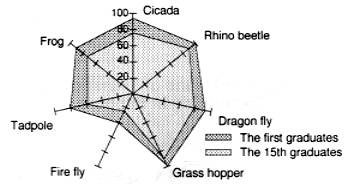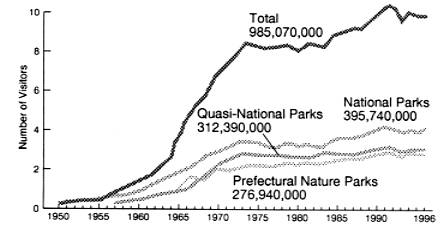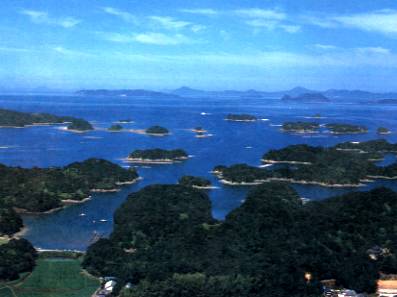Chapter III -2 :Quality of the Environment in Japan 1998
Chapter III: Transformation of Current Lifestyles
2. Life with full interaction with nature
It is important to come into contact with nature in our daily lives. Such interaction maintains coexistence between nature and human beings. Through such interaction, one can develop respect and love for nature, which is an important element when it comes to motivating people to establish a lifestyle of co-existence with reduced environmental load.
A transformed relationship between human beings and nature
Economic growth, which we strove for in order to obtain richer lives, brought about material wealth. However, it dug a trench in the middle of the relationship that existed between nature and human beings. Many citizens have been living in such a way that they do not directly feel the blessings of nature. In the immediate period following World War II, about 50% of the working population was engaged in primary industry. At present, less than 6% of the work-force is engaged in the primary industry sector. The majority of the work-force rapidly became 'salary men' and Japan's population has become concentrated in the three great metropolitan areas.
Percentage of Male Students with Insect and Frog Catching Experience

- Source:
- Compiled by the Environment Agency from "How Children's insect experiences have changed"
by Masao Taguchi
Conscious effort to create time to come in touch with nature in our daily lives
In recent years as leisure time has increased and environmental awareness risen, there has been a growing desire to have time to come in touch with nature. More people are also interested in their immediate natural environment.
National Opinion Poll on Protection and Utilization of Nature
(Do you want to increase your opportunities to interact with nature?)

- [1]
- I'd like to increase substantially.
- [2]
- I'd like to increase a little bit.
- [3]
- I'm satisfied with the present situation.
- [4]
- I don't particularly want to interact with nature.
- [5]
- Others / I don't know.
- Source:
- Compiled by the Environment Agency from the "National Opinion Poll on Protection and Utilization of Nature" by the Prime Minister's Office.
Bringing interaction with nature into our lives
Promotion of interaction opportunities using nature parks
Japan's nature parks possess highly natural areas, and are perfect places both to make contact with nature and for environmental learning. In nature parks, one can experience primeval nature that exists beyond human control, and it is possible to regain a sense of one's own human nature and at the same time experience the special emotions and joy that can only be felt by being in a natural environment. Also, because nature parks exist on a subtle balance including primary nature, it is necessary to utilize these facilities in a sustainable way, taking into full account these areas' environmental carrying capacities.
The number of users of nature parks in Japan has been growing over the years. The number grew especially dramatically after 1985 under the influence of the so-called "Resort Boom." After the "Bubble Economy" came to an end, the number of large-scale resort facility development schemes has come down. In recent years, the new concept of "Ecotourism" is attracting attention. It is a form of travel that does not damage the natural environment of an area and that offers plenty of opportunities for travelers to learn about and interact with local nature and culture.
Changes in the Number of Visitors to Nature Parks

- Note:
- Statistics for Quasi-National Parks exist from 1957 and for Prefectural Nature Parks from 1965.
- Source:
- Environment Agency

Looking over Kujuku Islands in Saikai National Park
In 1995, the Environment Agency launched the Comprehensive Project in Natural Park Core Areas (the Green Diamond Plan). The Environment Agency is also implementing the Eco-Museum Project for children to interact with and learn about nature. In 1997, the Agency began implementing the Commune-with-Nature School Project and the Commune-with-Nature School Activities Promotion Project. These projects involve the establishment of facilities to learn about nature and experience life and adventure in a natural context. They also entail formulation of participation-oriented nature experience learning programmes. Moreover, the "Love the Nature Club," which is a supporting group for the Commune-with Nature School, was established in August 1997. The National Park Resort (Kyukamura) Corporation is also developing plans to utilize each of its resort facilities as sites for environmental education and learning.
In Japan, the important roles of nature guide and leaders are being recognized and there is an increase in the number of places where such qualified people can work. However, there is an insufficient number of guides and leaders and more training is needed.
Outdoor activities, if carried out inappropriately, have the potential to damage the natural environment. Therefore it is important to provide guidelines on behavior for those who use nature parks for outdoor experiences. Besides government roles, the voluntary and positive contributions of outdoor groups is highly important. In the Southern Alpine National Park, the NGO Southern Alpine Club has been conducting scientific research on Alpine plants and also conducting awareness raising campaigns regarding toilets in the parks aimed at mountain climbers.
Interaction with immediate nature
Apart from leisure time, it is important to secure opportunities to feel and interact with immediate nature in our daily lives. Many immediate natural areas are owned privately and are therefore outside the jurisdiction of nature conservation laws. Since it is currently more economically profitable to transform natural areas, it is impossible for land owners to maintain them without any support. Therefore, a new movement has been seen where different parties such as governments, local residents and NGOs co-operate to manage immediate nature areas.
In 1994, local governments were granted an authority to promote the conservation of green spaces by formulating the Master plan of Parks and Open Spaces. This encouraged positive efforts at the local government level.
The Environment Agency is promoting the Countryside Nature Network Project to create places of nature interaction and rest, conserving and utilizing the immediate natural environment outside national and quasi-national parks.
In order to conserve immediate nature, efforts by local people and NGOs and cooperation with governments are needed. In Maioka Municipal Park in Yokohama City, in conjunction with local NGOs, nature in the city is conserved through agricultural activities by citizens. There are also citizens' forests in Yokohama City. In Nishi Yodogawa Ward in Osaka, the Center for the Redevelopment of Pollution-Damaged Areas in Japan was established in 1996, using the settlement fund of the asthma pollution law suit. The Center is trying to rehabilitate the regional environment, creating natural spaces in the area.
Experiences of coming into contact with nature make a lasting impression on individuals and could become an important trigger to develop consciousness for environmental conservation.
People Who Are Involved in Utilization of Natural Amenities
| Categories | Definition and Roles | Others |
|---|---|---|
| National Parks Manager (ranger) |
|
|
| Private Ranger |
|
|
| Volunteer |
|
|
| Naturalist (seasonal ranger) |
|
|